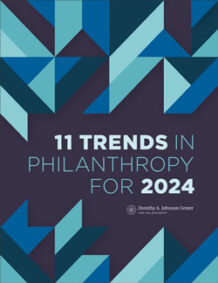Donor Anonymity Is Under the Microscope


 This article was first published in our 11 Trends in Philanthropy for 2024 report. Explore the full report here.
This article was first published in our 11 Trends in Philanthropy for 2024 report. Explore the full report here.
Want the latest trends, research, and more delivered right to your inbox? Subscribe to the Johnson Center email newsletter.
There are many reasons why a donor to a charitable organization may wish to remain anonymous — personal humility, religious conviction, or a desire to avoid public or family scrutiny, for example.
Yet what may seem a personal decision to a donor has become a battleground in philanthropy, politics, and the public square. While many of the issues tied up with anonymous charitable giving remain unresolved, debates over the merits, dangers, and even existence of anonymous giving will generate intense debate.
Nonprofits annually submit a list of their major donors to the federal government through the Schedule B supplement of the IRS Form 990. For Form 990-PF and Section 527 political organization filers, those lists are already required to be publicly accessible (IRS, 2022, p. 5). For all other filers, however, that list has traditionally been considered highly sensitive and confidential.
The U.S. Supreme Court’s 1958 ruling in NAACP v. Alabama (Justia, n.d.) set this precedent. Citing the very real physical, economic, and social dangers NAACP donors and members faced at the time, the case affirmed donors’ constitutional right to privacy through “free association.”
In 2010, the Supreme Court’s ruling on Citizens United v. FEC changed the game (Federal Election Commission). That ruling ushered in an era of mounting concerns about the influence of private individuals, corporations, and labor unions on U.S. elections. State and federal legislators began introducing legislation to make these donations public, arguing for transparency in the interest of fighting fraud, addressing mismanagement in governance (Totenberg, 2021), and rooting out “dark money” and foreign funding (Kennedy, 2023) from politics.
The issue has garnered so much public interest that Balletopedia launched a dedicated email newsletter on the topic, The Disclosure Digest, in February 2019. Five years later, the platform is still active — as is the debate. While aiming to bring transparency to campaign finance, opponents argue these regulations could infringe on donors’ established rights to free speech and association. “When considering disclosure rules,” wrote Elizabeth McGuigan of Philanthropy Roundtable (2021), “clear distinctions must be made between charitable association and political activity” (para. 1).
Advocates of donor privacy believe the question was settled in 2021 with the Supreme Court’s 6-3 ruling in the case of Americans for Prosperity Foundation v. [California Attorney General Rob] Bonta. That ruling determined that California could not force nonprofits to submit lists of their major donors to the state. Despite what might have seemed to be the final word on the subject, Ballotpedia counted 70+ proposed bills in state legislatures calling for greater disclosure in 2022, and more than 50 in 2023 as of October.
An unresolved quandary here is the question of effective regulation of the sector and the enforcement of existing (let alone new) statutes. Without public disclosure and a fulsome understanding of current practices, especially unintentional versus real malfeasance, regulators and watchdogs will struggle to do their jobs fully. On the other hand, as critics point out, the California regulations struck down in 2015 had failed to uncover any meaningful fraud in more than 10 years of donor list review — calling into question the true necessity of such disclosure (Parnell, 2017).
Within the philanthropic sector, donor anonymity continues to be hotly debated. After all, peer-to-peer influence is a well-known factor in motivating others to give, while enforced public disclosure might prevent some from giving altogether (Murphy, 2023).
What is uniquely interesting about this issue is that opinions do not fall neatly along the ideological spectrum. Philanthropy Roundtable, generally considered right-leaning in the sector, is joined by the American Civil Liberties Union (2021), the NAACP Legal Defense and Education Fund, and the Human Rights Campaign (all typically seen as left-leaning organizations) in advocating staunchly for donors’ rights to free speech and free association through privacy (McGuigan, 2021).
As the fastest-growing giving vehicle in the U.S., donor-advised funds (DAFs) have become a part of the debate, as well. By their very nature, DAFs can obscure the source of a grant. Countless anecdotes from the field recount occasions when the check arrived and nonprofits had little more to go on than the name of the account sponsor. This scenario can create or advance donor anonymity and obstruct usual protocols of stewardship, due diligence, and reporting.
By far, most DAF disbursements come with a donor-advisor’s name attached or are intended to do so. Research from the American Enterprise Institute (2022) reported that only 4.3% of all grants disbursed in 2020 from DAFs at the five largest DAF sponsors — Fidelity Charitable Trust, National Philanthropic Trust, Schwab Charitable, Silicon Valley Community Foundation, and Vanguard Charitable — were made anonymously (Husock).
However, unless a nonprofit chooses to publicize the names of those donor-advisors, gifts essentially remain anonymous. This reality drew sharp criticism when reporting from The Chronicle of Philanthropy (building on research from the Council for American-Islamic Relations [Council on Foundations, 2020] and Sludge [Kotch, 2019]) revealed more than $50 million in DAF disbursements to organizations designated by the Southern Poverty Law Center as hate groups (Theis, 2021). In response, the Amalgamated Foundation (2021) launched the Hate is Not Charitable Campaign to rally donors and DAF sponsors around a shared commitment to filter out these organizations, specifically calling out “donors, acting anonymously” (para. 1).
Public opinion on anonymous donations to charitable organizations is mixed and often driven by perceived conflicts of interest (or scandal) if and when donors’ identities are revealed. The WHO Foundation came under fire in July 2023 when it was revealed that 40% of the organization’s donations were anonymous, raising questions about transparency and influence on global health policy (Beaty, 2023). At MIT and Harvard, public outcry in response to the revelation that these universities accepted large anonymous donations from Jeffrey Epstein led both schools to reconsider their anonymous donation policies (Carapezza, 2019). These examples highlight very real questions about the influence of donors on research priorities, policy questions, institutional reputations, and much more — and whether students and other constituents have the right to know who is behind these resources.
“At MIT and Harvard, public outcry in response to the revelation that these universities accepted large anonymous donations from Jeffrey Epstein led both schools to reconsider their anonymous donation policies.”
Even still, anonymous donations may be on the rise — especially within higher education — demonstrating donors’ (and, therefore, at least a portion of the public’s) appetite for maintaining anonymity. In 2023 alone, anonymous gifts to McPherson College ($500 million, on top of an initial $500 million pledge in 2022 [Nietzel, 2023a]), Montefiore Einstein’s College of Medicine ($100 million [Landoli, 2023]), and the University of Kansas ($50 million [Nietzel, 2023b]) are just the tip of the iceberg.
In the 12th century, Jewish scholar Maimonides defined an eight-step ladder of charitable action that named the second highest form of giving as a scenario in which the donor and recipient both remain anonymous (Chabad.org). In the New Testament, the admonition from Jesus that “when you give to the poor, do not let your left hand know what your right hand is doing” has also echoed through the centuries. Today, the spirit of this philosophy continues to influence donors, fundraisers, and the general public — even as its practical application comes under the microscope.


Amalgamated Foundation. (n.d.). Hate is Not Charitable Campaign. https://www.amalgamatedfoundation.org/hate-is-not-charitable-campaign
American Civil Liberties Union (2021, March 2). ACLU, partner orgs file SCOTUS amicus brief supporting privacy rights of nonprofit donors. https://www.aclu.org/press-releases/aclu-partner-orgs-file-scotus-amicus-brief-supporting-privacy-rights-nonprofit-donors
Ballotpedia. (2023, October). Donor privacy and disclosure policy in the United States, 2019-present. https://ballotpedia.org/Donor_privacy_and_disclosure_policy_in_the_United_States,_2019-present
Beaty, T. (2023, July 20). Undue influence? Anonymous donations to World Health Organization’s new foundation raise concerns. The Associated Press. https://apnews.com/article/who-foundation-global-health-funding-e1a35f3ef63356100f07549f317512ca#
Carapezza, K. (2019, September 17). After taking Jeffrey Epstein’s money, MIT And Harvard reconsider “anonymous” donations. GBH. https://www.wgbh.org/news/education-news/2019-09-17/after-taking-jeffrey-epsteins-money-mit-and-harvard-reconsider-anonymous-donations
Chabad.org. (n.d.). Maimonides’ eight levels of charity. Mishneh Torah, Laws of Charity, 10:7–14. https://www.chabad.org/library/article_cdo/aid/45907/jewish/Eight-Levels-of-Charity.htm
Council on Foundations. (2020). The Cleveland Foundation anti-hate policy change for grants from donor advised funds. https://cof.org/content/cleveland-foundation-anti-hate-policy-change-grants-donor-advised-funds
Federal Election Commission. (n.d.). Citizens United v. FEC. https://www.fec.gov/legal-resources/court-cases/citizens-united-v-fec/
Husock, H. (2022, January). Anonymous giving through donor-advised funds. Aei.org. https://www.aei.org/wp-content/uploads/2022/01/Anonymous-giving-through-donor-advised-funds.pdf
IRS. (2022). Schedule of contributors. Schedule B (Form 990). Department of the Treasury. https://www.irs.gov/pub/irs-pdf/f990ezb.pdf
Justia. (n.d.) NAACP v. Alabama ex rel. Patterson, 357 U.S. 440 (1958). https://supreme.justia.com/cases/federal/us/357/449/
Kennedy, C. (2023, November 2). The nonprofit world should embrace, not fear, congressional interest in donor transparency. The Chronicle of Philanthropy. https://www.philanthropy.com/article/the-nonprofit-world-should-embrace-not-fear-congressional-interest-in-donor-transparency
Kotch, A. (2019, November 22). Nation’s biggest charity is funding influential white nationalist group. Sludge. https://readsludge.com/2019/11/22/nations-biggest-charity-is-funding-influential-white-nationalist-group/
Landoli, E. (2023, March 2). Montefiore Einstein announces $100 million contribution to Albert Einstein College of Medicine. Albert Einstein College of Medicine. https://www.einsteinmed.edu/news/9968/montefiore-einstein-announces-$100-million-contribution-to-albert-einstein-college-of-medicine/
McGuigan, E. (2021, November 1). Donor privacy: A constitutional right for American givers. Philanthropy Roundtable. https://www.philanthropyroundtable.org/resource/donor-privacy-a-constitutional-right-for-american-givers/
Murphy, B. (2023, May 15). The rise of anonymous giving: Impact and implications for nonprofits. Graham-Pelton. https://grahampelton.com/insights/the-rise-of-anonymous-giving-impact-and-implications-for-nonprofits/
Nietzel, M. T. (2023a, July 22). Anonymous donor pledges a second $500 million gift to small Kansas college. Forbes. https://www.forbes.com/sites/michaeltnietzel/2023/07/22/anonymous-donor-pledges-a-second-500-million-gift-to-mcpherson-college/?sh=dcd445042de9
Nietzel, M. T. (2023b, September 6). University Of Kansas receives historic $50 million gift from anonymous donor. Forbes. https://www.forbes.com/sites/michaeltnietzel/2023/09/06/university-of-kansas-receives-historic-50-million-gift-from-anonymous-donor/
Parnell, S. (2017, Spring). The legal and political landscape of donor privacy. Philanthropy Roundtable. https://www.philanthropyroundtable.org/magazine/spring-2017-the-legal-and-political-landscape-of-donor-privacy/
Supreme Court of the United States. (2021, July 1). Americans for Prosperity Foundation v. Bonta, Attorney General of California. https://www.supremecourt.gov/opinions/20pdf/19-251_p86b.pdf
The Disclosure Digest. (n.d.). Ballotpedia’s Disclosure Digest Archive. (2021). Ballotpedia. https://ballotpedia.org/Ballotpedia%27s_Disclosure_Digest_Archive
Theis, M. (2021, February 3). ‘Hate Groups’ received millions from 351 charities and foundations, Chronicle review finds. The Chronicle of Philanthropy. https://www.philanthropy.com/article/351-charities-and-foundations-directed-millions-to-hate-groups-chronicle-review-finds
Totenberg, N. (2021, July 1). The Supreme Court throws out a state law requiring nonprofits to name rich donors. NPR. https://www.npr.org/2021/07/01/1004062322/the-supreme-court-guts-a-state-law-requiring-nonprofits-to-name-their-rich-donor